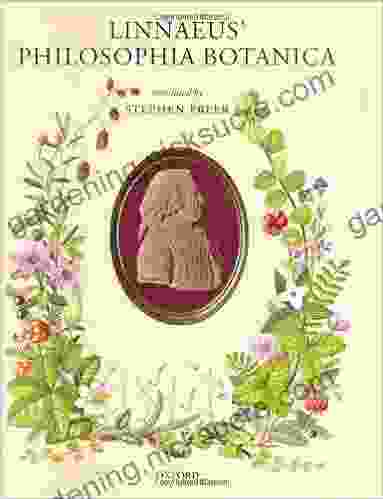Linnaeus Philosophia Botanica

Abstract
Carolus Linnaeus' Philosophia Botanica (1751) revolutionized botanical classification by introducing a hierarchical system based on the reproductive structures of plants. This system, known as the Linnaean system, formed the foundation for modern scientific taxonomy and laid the groundwork for the discovery and understanding of plant diversity.
Before Linnaeus, botanical classification was inconsistent and largely based on arbitrary characteristics. This hindered scientific communication and made it difficult to compare and identify plant species accurately. Linnaeus' Philosophia Botanica addressed this problem by providing a systematic and logical framework for categorizing plants.
The Linnaean System
The Linnaean system divides the plant kingdom into a hierarchical structure of categories. Each category represents a taxonomic rank, with the highest rank being the kingdom and the lowest being the species. The ranks, in descending order, are:
4.1 out of 5
| Language | : | English |
| File size | : | 4973 KB |
| Text-to-Speech | : | Enabled |
| Screen Reader | : | Supported |
| Print length | : | 432 pages |
| Lending | : | Enabled |
- Kingdom
- Class
- Order
- Family
- Genus
- Species
Plants are classified into ranks based on shared characteristics. For example, all plants with flowers that have two cotyledons (seed leaves) belong to the class Dicotyledoneae. Within the class, plants with a whorled flower arrangement are assigned to the order Gentianales.
The Importance of Reproductive Structures
Linnaeus emphasized the importance of reproductive structures, particularly the stamens (male organs) and pistils (female organs),in plant classification. He believed that these structures provided the most consistent and reliable characteristics for differentiating species.
Binomial Nomenclature
One of Linnaeus' most significant contributions was the of binomial nomenclature. This system gives each species a unique two-word name consisting of its genus and species epithets. The genus name is common to all species within a genus, while the species epithet distinguishes one species from another.
For example, the scientific name for the common daisy is "Bellis perennis." The genus name "Bellis" applies to all daisy species, while the species epithet "perennis" indicates that this particular species is perennial.
The Impact of Philosophia Botanica
Philosophia Botanica had a profound impact on the development of botany. It:
- Established a standardized system for plant classification, making it easier to communicate and compare scientific information.
- Provided a basis for identifying and describing new plant species.
- Laid the foundation for future botanical discoveries and advancements.
Influence on Modern Taxonomy
The Linnaean system remains the cornerstone of modern taxonomy. While it has undergone some modifications and refinements over time, its basic principles are still widely used today. The hierarchical structure and reliance on reproductive structures continue to guide the classification of plants and other organisms.
Linnaeus' Philosophia Botanica was a groundbreaking work that revolutionized botanical classification. Its of a hierarchical system based on reproductive structures provided a consistent and logical framework for categorizing plants. Binomial nomenclature, a major innovation introduced by Linnaeus, enabled the precise identification and naming of species. The legacy of Philosophia Botanica continues to shape the field of botany and the study of biodiversity.
4.1 out of 5
| Language | : | English |
| File size | : | 4973 KB |
| Text-to-Speech | : | Enabled |
| Screen Reader | : | Supported |
| Print length | : | 432 pages |
| Lending | : | Enabled |
Do you want to contribute by writing guest posts on this blog?
Please contact us and send us a resume of previous articles that you have written.
 Fiction
Fiction Non Fiction
Non Fiction Romance
Romance Mystery
Mystery Thriller
Thriller SciFi
SciFi Fantasy
Fantasy Horror
Horror Biography
Biography Selfhelp
Selfhelp Business
Business History
History Classics
Classics Poetry
Poetry Childrens
Childrens Young Adult
Young Adult Educational
Educational Cooking
Cooking Travel
Travel Lifestyle
Lifestyle Spirituality
Spirituality Health
Health Fitness
Fitness Technology
Technology Science
Science Arts
Arts Crafts
Crafts DIY
DIY Gardening
Gardening Petcare
Petcare Paul Martin
Paul Martin Ellen Sue Turner
Ellen Sue Turner Tim R Wolf
Tim R Wolf David Lloyd Kilmer
David Lloyd Kilmer Rashad Jennings
Rashad Jennings Clint Malarchuk
Clint Malarchuk Jacquetta Hawkes
Jacquetta Hawkes Bernard Cornwell
Bernard Cornwell Bernard Rosner
Bernard Rosner Shonna Slayton
Shonna Slayton Andrew Shapland
Andrew Shapland Kristine Setting Clark
Kristine Setting Clark Steven D Levitt
Steven D Levitt Marie Louise Von Franz
Marie Louise Von Franz Cassandra Johnson
Cassandra Johnson L Ulloque
L Ulloque Starley Talbott
Starley Talbott Claudio De Castro
Claudio De Castro Donna M Mertens
Donna M Mertens Gregory J Privitera
Gregory J Privitera Michael Alvear
Michael Alvear Eli Boschetto
Eli Boschetto Justin Hammond
Justin Hammond Dave Gerr
Dave Gerr Kerry Fraser
Kerry Fraser Jenifer Fox
Jenifer Fox Dalai Lama
Dalai Lama 3rd Edition Kindle Edition
3rd Edition Kindle Edition Ricki E Kantrowitz
Ricki E Kantrowitz Lj Rivers
Lj Rivers Robert A Johnson
Robert A Johnson Patrick Viafore
Patrick Viafore Linda A Roussel
Linda A Roussel Christa Orecchio
Christa Orecchio Peter Cossins
Peter Cossins Richard Adams
Richard Adams Robert Venditti
Robert Venditti Wong Kiew Kit
Wong Kiew Kit Patricia Moore Pastides
Patricia Moore Pastides Barnett Rich
Barnett Rich Eric I Karchmer
Eric I Karchmer Tom Mchale
Tom Mchale Karl Morris
Karl Morris 1st Ed 2016 Edition Kindle Edition
1st Ed 2016 Edition Kindle Edition 006 Edition Kindle Edition
006 Edition Kindle Edition Alessa Ellefson
Alessa Ellefson Leslie Leyland Fields
Leslie Leyland Fields Tony Hernandez Pumarejo
Tony Hernandez Pumarejo Nick Winkelman
Nick Winkelman Buddy Martin
Buddy Martin James Diego Vigil
James Diego Vigil William Regal
William Regal Cindy Kennedy
Cindy Kennedy Sheryl Crow
Sheryl Crow A C Davison
A C Davison Edyta Roszko
Edyta Roszko Caroline Porter Thomas
Caroline Porter Thomas Keith Siragusa
Keith Siragusa Juno Dawson
Juno Dawson Deanne Howell
Deanne Howell Tom Lyons
Tom Lyons A R Bernard
A R Bernard Sadie Radinsky
Sadie Radinsky Andrew Maraniss
Andrew Maraniss Nathan Jendrick
Nathan Jendrick Roselyn Teukolsky
Roselyn Teukolsky Paul Johnson
Paul Johnson Diane Duane
Diane Duane William A Dembski
William A Dembski Jasmine Greene
Jasmine Greene Skye Genaro
Skye Genaro Lois Duncan
Lois Duncan 50minutos Es
50minutos Es Kenny Casanova
Kenny Casanova Anthony Arvanitakis
Anthony Arvanitakis Tony Horton
Tony Horton Jillian Dodd
Jillian Dodd Edward Frenkel
Edward Frenkel Porter Fox
Porter Fox John Iceland
John Iceland Elizabeth Sims
Elizabeth Sims Jong Chul Ye
Jong Chul Ye Claire Sierra
Claire Sierra Amy Chua
Amy Chua John Kreiter
John Kreiter 5th Edition Kindle Edition
5th Edition Kindle Edition Natasha Preston
Natasha Preston Andrea Wulf
Andrea Wulf Syougo Kinugasa
Syougo Kinugasa Kristi K Hoffman
Kristi K Hoffman Roger Gordon
Roger Gordon Justin Bower
Justin Bower Kerri Maniscalco
Kerri Maniscalco Nnedi Okorafor
Nnedi Okorafor Carl J Sindermann
Carl J Sindermann Claire Baker
Claire Baker Josh Mulvihill
Josh Mulvihill Brooklyn James
Brooklyn James Martin Mobraten
Martin Mobraten Elizabeth Wenk
Elizabeth Wenk Manhattan Prep
Manhattan Prep Lareina Rule
Lareina Rule Kekla Magoon
Kekla Magoon David Kushner
David Kushner Thomas R Baechle
Thomas R Baechle Rick Gurnsey
Rick Gurnsey Louis Stanislaw
Louis Stanislaw Daphne Adler
Daphne Adler Pat Dorsey
Pat Dorsey Prerna Lal
Prerna Lal Susan Walker
Susan Walker Lenora Ucko
Lenora Ucko Geoffrey West
Geoffrey West Ernest Shackleton
Ernest Shackleton Dan Falk
Dan Falk Bruno Latour
Bruno Latour Lewis Henry Morgan
Lewis Henry Morgan 2nd Edition Kindle Edition
2nd Edition Kindle Edition Justin Doyle
Justin Doyle Eric Haseltine
Eric Haseltine Mauricio Cabrini
Mauricio Cabrini Breanna Lam
Breanna Lam Leon Anderson
Leon Anderson 4th Edition Kindle Edition
4th Edition Kindle Edition Edward Rosenfeld
Edward Rosenfeld Tasha Dunn
Tasha Dunn Stewart Smith
Stewart Smith Freda Mcmanus
Freda Mcmanus 2012th Edition Kindle Edition
2012th Edition Kindle Edition Lesli Richards
Lesli Richards Miranda Castro
Miranda Castro Kristen Riecke
Kristen Riecke Sandra Mizumoto Posey
Sandra Mizumoto Posey Frank Sargeant
Frank Sargeant Marisha Pessl
Marisha Pessl Suzie Cooney
Suzie Cooney Jay Cassell
Jay Cassell Emma Dalton
Emma Dalton Greta Solomon
Greta Solomon Debra Pascali Bonaro
Debra Pascali Bonaro Jo Frost
Jo Frost Jd Brown
Jd Brown Patrick Hunt
Patrick Hunt Andy Charalambous
Andy Charalambous Olszewski Marie Erin
Olszewski Marie Erin Robert Pondiscio
Robert Pondiscio Ziemowit Wojciechowski
Ziemowit Wojciechowski Rifujin Na Magonote
Rifujin Na Magonote Patricia O Quinn
Patricia O Quinn Leigh Calvez
Leigh Calvez Greg Midland
Greg Midland Stephen P Anderson
Stephen P Anderson Natalie Smith
Natalie Smith Jon Dunn
Jon Dunn Collins Gcse
Collins Gcse Theodore X O Connell
Theodore X O Connell Neal Bascomb
Neal Bascomb Raymond H Thompson
Raymond H Thompson Brian Thompson
Brian Thompson 8th Edition Kindle Edition
8th Edition Kindle Edition Joe Oliver
Joe Oliver Oliver Theobald
Oliver Theobald David Simkins
David Simkins Jason Curtis
Jason Curtis Z Justin Ren
Z Justin Ren Alan Jacobs
Alan Jacobs Susan E Cayleff
Susan E Cayleff Filipe Masetti Leite
Filipe Masetti Leite Naomi Scott
Naomi Scott Mark Brazil
Mark Brazil Pamela Adams
Pamela Adams Sarah Templeton
Sarah Templeton Laurie Forest
Laurie Forest George W E Nickelsburg
George W E Nickelsburg Maureen Johnson
Maureen Johnson Deepak Chopra
Deepak Chopra Melissa Cheyney
Melissa Cheyney Jamaica Stevens
Jamaica Stevens Dominik Hartmann
Dominik Hartmann Bill Reif
Bill Reif Mark Hatmaker
Mark Hatmaker Adam Silvera
Adam Silvera Nikki Grimes
Nikki Grimes Jeremy Desilva
Jeremy Desilva Gregory Collins
Gregory Collins Bob Welch
Bob Welch Carol Stock Kranowitz
Carol Stock Kranowitz Garrett Grolemund
Garrett Grolemund Eloise Jarvis Mcgraw
Eloise Jarvis Mcgraw Riddleland
Riddleland John Green
John Green Michael Geheran
Michael Geheran Whit Honea
Whit Honea Oscar Wegner
Oscar Wegner Sherry Monahan
Sherry Monahan Lucas Whitecotton
Lucas Whitecotton Nadav Snir
Nadav Snir Joe Cuhaj
Joe Cuhaj Jessica Shortall
Jessica Shortall David Beaupre
David Beaupre John Hands
John Hands Jeffrey A Greene
Jeffrey A Greene Andrew Weber
Andrew Weber Samantha Lovely
Samantha Lovely Jean Clottes
Jean Clottes Heather Job
Heather Job Al Ford
Al Ford Glenn N Levine
Glenn N Levine Harry Middleton
Harry Middleton Geri Ann Galanti
Geri Ann Galanti Patrick E Mcgovern
Patrick E Mcgovern Dan Blackburn
Dan Blackburn A C Grayling
A C Grayling Broccoli Lion
Broccoli Lion Mohamed Elgendy
Mohamed Elgendy Elizabeth D Hutchison
Elizabeth D Hutchison Robert S Mueller
Robert S Mueller Laura Bright
Laura Bright Richard Ania
Richard Ania Yan Shen
Yan Shen Stefan Hofer
Stefan Hofer Andrew G Marshall
Andrew G Marshall Theresa Cheung
Theresa Cheung Richard Bromfield
Richard Bromfield Manuel De La Cruz
Manuel De La Cruz E Bruce Goldstein
E Bruce Goldstein P G Maxwell Stuart
P G Maxwell Stuart Howard Mudd
Howard Mudd G I Gurdjieff
G I Gurdjieff Katie J Trent
Katie J Trent Elaine Beaumont
Elaine Beaumont Grant Thompson
Grant Thompson Eric Dominy
Eric Dominy John A Yoegel
John A Yoegel John Gribbin
John Gribbin Jason Miller
Jason Miller Chris I Naylor
Chris I Naylor Dr Katayune Kaeni
Dr Katayune Kaeni Chase Williams
Chase Williams Marcia Verduin
Marcia Verduin 4th Edition Kindle Edition With Audio Video
4th Edition Kindle Edition With Audio Video Gary S Thorpe
Gary S Thorpe Aubrey Clayton
Aubrey Clayton Robert Thurston
Robert Thurston Liesbet Collaert
Liesbet Collaert Barbara Klein
Barbara Klein Robert K Tyson
Robert K Tyson Kelly Skeen
Kelly Skeen Robert Ferguson
Robert Ferguson Katie M John
Katie M John Gershon Ben Keren
Gershon Ben Keren Steve Kantner
Steve Kantner Kyla Stone
Kyla Stone Apsley Cherry Garrard
Apsley Cherry Garrard Meik Wiking
Meik Wiking Icon Digital Publishing
Icon Digital Publishing Jim Burns
Jim Burns L S Boos
L S Boos Thomas Wentworth Higginson
Thomas Wentworth Higginson Jonathan Ross
Jonathan Ross Peter Dewhurst
Peter Dewhurst Tom Pyszczynski
Tom Pyszczynski Jozef Nauta
Jozef Nauta Lars Behnke
Lars Behnke Christoph Delp
Christoph Delp Tracy Gharbo
Tracy Gharbo Chris Froome
Chris Froome Temple Grandin
Temple Grandin John Collins
John Collins Mary H K Choi
Mary H K Choi Brian Kent
Brian Kent Lee Smolin
Lee Smolin Ellen Levitt
Ellen Levitt Josh Elster
Josh Elster Jeff Gill
Jeff Gill Gail Craswell
Gail Craswell Louis Liebenberg
Louis Liebenberg Michael Clarke
Michael Clarke A Digger Stolz
A Digger Stolz Monica Sorrenson
Monica Sorrenson Robert Bauval
Robert Bauval Jamie Hand
Jamie Hand Sam Irwin
Sam Irwin Gianni La Forza
Gianni La Forza Raymond Buckland
Raymond Buckland Michael S Gazzaniga
Michael S Gazzaniga Ben Egginton
Ben Egginton Patrick Lange
Patrick Lange Kate Spencer
Kate Spencer Eva Feder Kittay
Eva Feder Kittay Alec Crawford
Alec Crawford Mitch Rubman
Mitch Rubman Dinokids Press
Dinokids Press Russell Miller
Russell Miller Margaret Littman
Margaret Littman Andre Norton
Andre Norton Sam Goulden
Sam Goulden Micah Goodman
Micah Goodman Jack M Bloom
Jack M Bloom Simon G Thompson
Simon G Thompson Sloane Mcclain
Sloane Mcclain Jasper Godwin Ridley
Jasper Godwin Ridley Christy Jordan
Christy Jordan John Gookin
John Gookin 50minutes Com
50minutes Com Iris Bohnet
Iris Bohnet 2005th Edition Kindle Edition
2005th Edition Kindle Edition Terence Grieder
Terence Grieder Kennedy Achille
Kennedy Achille Diamond Wilson
Diamond Wilson Shelby Hailstone Law
Shelby Hailstone Law Robert Peter Gale
Robert Peter Gale Max Domi
Max Domi Erika Bornman
Erika Bornman Steve Garnett
Steve Garnett Kevin Paul
Kevin Paul Janetti Marotta
Janetti Marotta Michael W Ford
Michael W Ford Leonardo Trasande
Leonardo Trasande Gayle Jervis
Gayle Jervis Michael Romano
Michael Romano Theodor W Adorno
Theodor W Adorno Terrence Real
Terrence Real Michaela Stith
Michaela Stith Amy Ogle
Amy Ogle Bryan Smith
Bryan Smith Peter Wohlleben
Peter Wohlleben J Morgan Mcgrady
J Morgan Mcgrady Bertolt Brecht
Bertolt Brecht Herbert Feigl
Herbert Feigl Bobby Blair
Bobby Blair Leonard Pellman
Leonard Pellman Chris Stewart
Chris Stewart Justine Brooks Froelker
Justine Brooks Froelker Betty Crocker
Betty Crocker George Pendle
George Pendle Jordan Ifueko
Jordan Ifueko Nathalie Dupree
Nathalie Dupree Nancy Keene
Nancy Keene Elizabeth Bradfield
Elizabeth Bradfield Kate Usher
Kate Usher Dr Danny Penman
Dr Danny Penman Emily A Duncan
Emily A Duncan Alden Jones
Alden Jones Andrew Collins
Andrew Collins Kelly Slater
Kelly Slater Mark V Wiley
Mark V Wiley Gregory A Boyd
Gregory A Boyd Paul Deepan
Paul Deepan Marty Bartholomew
Marty Bartholomew Tok Hui Yeap Rd Csp Ld
Tok Hui Yeap Rd Csp Ld Mimi Lemay
Mimi Lemay Steve Magness
Steve Magness Bonnie Scott
Bonnie Scott Christopher Mcdougall
Christopher Mcdougall Joseph E Garland
Joseph E Garland James Mcnicholas
James Mcnicholas Joe Chilson
Joe Chilson Muata Ashby
Muata Ashby Joseph Chilton Pearce
Joseph Chilton Pearce Aly Madhavji
Aly Madhavji 1st Edition Kindle Edition
1st Edition Kindle Edition A Christine Harris
A Christine Harris Nate G Hilger
Nate G Hilger Tyler Vanderweele
Tyler Vanderweele Subsequent Edition Kindle Edition
Subsequent Edition Kindle Edition Don Fink
Don Fink Christopher Lakeman
Christopher Lakeman Brenda Dehaan
Brenda Dehaan Dervla Murphy
Dervla Murphy Gina Rae La Cerva
Gina Rae La Cerva Chris Dietzel
Chris Dietzel Bookrags Com
Bookrags Com Alice Ginott
Alice Ginott Janet Sasson Edgette
Janet Sasson Edgette Hong Chen
Hong Chen Heather Demetrios
Heather Demetrios Terence N D Altroy
Terence N D Altroy Jay Wilkinson
Jay Wilkinson Evan Brashier
Evan Brashier 7th Edition Kindle Edition
7th Edition Kindle Edition Robert Mcentarffer
Robert Mcentarffer Monte Burch
Monte Burch Duy Tran
Duy Tran 6th Edition Kindle Edition
6th Edition Kindle Edition Dustyn Roberts
Dustyn Roberts James D Long
James D Long Bruce Watson
Bruce Watson Theris A Touhy
Theris A Touhy Patricia S Potter Efron
Patricia S Potter Efron Rowan Ricardo Phillips
Rowan Ricardo Phillips Seymour Simon
Seymour Simon J Michael Leger
J Michael Leger Bree Moore
Bree Moore Vibrant Publishers
Vibrant Publishers L Madison
L Madison Martha Menchaca
Martha Menchaca Debra Barnes
Debra Barnes Patricia Stevens
Patricia Stevens Lin Pardey
Lin Pardey Charles Seife
Charles Seife Cynthia Bourgeault
Cynthia Bourgeault Naomi Feil
Naomi Feil Dr Brenda Stratton
Dr Brenda Stratton 1st English Ed Edition Kindle Edition
1st English Ed Edition Kindle Edition Karen Myers
Karen Myers Brennan Barnard
Brennan Barnard Heather Rain Mazen Korbmacher
Heather Rain Mazen Korbmacher Miko Flohr
Miko Flohr Allan Mundsack
Allan Mundsack Tami Lynn Kent
Tami Lynn Kent Ulla Sarmiento
Ulla Sarmiento Mei Fong
Mei Fong David Cheng
David Cheng 3rd Ed Edition Kindle Edition
3rd Ed Edition Kindle Edition Chris Lehto
Chris Lehto Jacqueeia Ferguson
Jacqueeia Ferguson John Coleman
John Coleman Dan Wingreen
Dan Wingreen Mike Tyson
Mike Tyson Jiichi Watanabe
Jiichi Watanabe Fata Ariu Levi
Fata Ariu Levi Emma Lord
Emma Lord J D Salinger
J D Salinger Mark Gregston
Mark Gregston Billie Jean King
Billie Jean King
Light bulbAdvertise smarter! Our strategic ad space ensures maximum exposure. Reserve your spot today!

 Frank ButlerUnveiling the Time Illusion: An Immersive Literary Journey into the Enigma of...
Frank ButlerUnveiling the Time Illusion: An Immersive Literary Journey into the Enigma of... Paul ReedFollow ·17.9k
Paul ReedFollow ·17.9k Greg FosterFollow ·5.2k
Greg FosterFollow ·5.2k Jean BlairFollow ·19.5k
Jean BlairFollow ·19.5k Adam HayesFollow ·8.5k
Adam HayesFollow ·8.5k Ervin BellFollow ·2.5k
Ervin BellFollow ·2.5k Brody PowellFollow ·8.7k
Brody PowellFollow ·8.7k Leo MitchellFollow ·2.5k
Leo MitchellFollow ·2.5k George Bernard ShawFollow ·11.2k
George Bernard ShawFollow ·11.2k

 Finn Cox
Finn CoxA Comprehensive Guide for Budding Inventors and Backyard...
For those with a restless mind and a...

 Forrest Reed
Forrest ReedThe Ultimate Shopper's Guide to Purchasing Weight Lifting...
Are you looking...

 Dillon Hayes
Dillon HayesThe Chemical Choir: Unveiling the Enchanting Symphony of...
In the enigmatic realm of science, where...

 Ryūnosuke Akutagawa
Ryūnosuke AkutagawaStumbling Thru: Hike Your Own Hike
In the realm of outdoor adventures,...

 Terry Pratchett
Terry PratchettUnlock Your Math Skills: A Comprehensive Guide to Chenier...
Math plays a vital role in...
4.1 out of 5
| Language | : | English |
| File size | : | 4973 KB |
| Text-to-Speech | : | Enabled |
| Screen Reader | : | Supported |
| Print length | : | 432 pages |
| Lending | : | Enabled |












